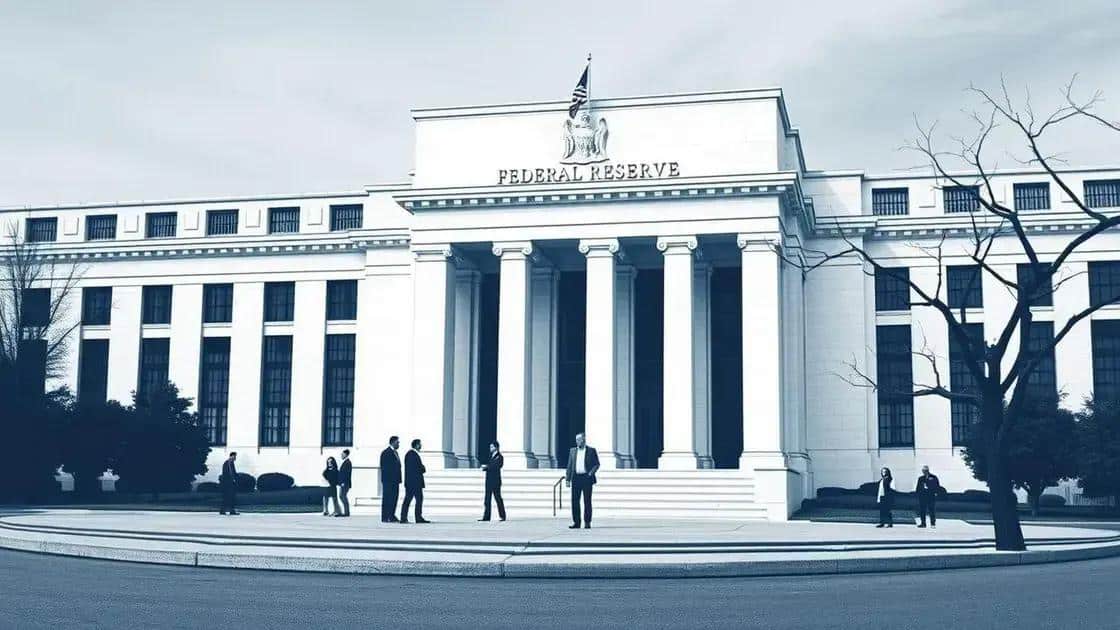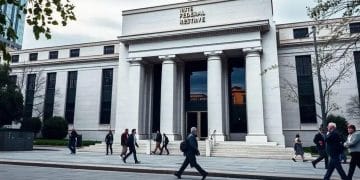Federal Reserve policy impact analysis: what it means for you

The analysis of Federal Reserve policy impact reveals significant effects on interest rates, consumer spending, and business growth, shaping the broader economic landscape.
Federal Reserve policy impact analysis plays a vital role in understanding our economic landscape. Curious about how recent decisions influence your daily finances? Let’s dive into the key aspects.
Understanding Federal Reserve policy changes
Understanding Federal Reserve policy changes is crucial for grasping the dynamics of our economy. These decisions can have wide-ranging effects on everything from inflation rates to employment levels. Let’s explore what these changes mean and how they may impact your finances.
Key Aspects of Federal Reserve Policies
The Federal Reserve, often referred to as the Fed, adjusts its policies based on economic conditions. Here are some key aspects to consider:
- The federal funds rate plays a significant role in influencing borrowing costs.
- Changes to reserve requirements can impact how much banks can lend.
- Quantitative easing is used to stimulate the economy by increasing money supply.
- Inflation control is a primary objective of the Fed’s policies.
When the Fed raises interest rates, it usually aims to combat inflation. Higher rates can make loans costlier for consumers and businesses, potentially slowing down spending. Conversely, lowering rates often encourages borrowing and investment, which can lead to economic growth.
Impact on Daily Life
The effects of these policies trickle down to everyday life. For example, when the Fed changes rates, you may notice shifts in:
- Mortgage rates: As borrowing costs change, homebuyers often feel the impact.
- Credit card interest: Higher rates can lead to increased payments on credit cards.
- Investment returns: The stock market often reacts to Fed announcements, affecting your investments.
Moreover, businesses must adapt to these policy changes as well. For example, companies may reassess their expansion plans based on expected changes in interest rates. This adaptability can be crucial for long-term success.
In summary, comprehending Federal Reserve policy changes is essential not only for economists but also for individuals and businesses alike. By staying informed, you can better navigate the financial landscape shaped by these policies.
Economic implications of current policies

The economic implications of current policies set forth by the Federal Reserve are vast and can significantly influence various aspects of our daily lives. These policies not only affect financial markets but also ripple through the economy, impacting employment, consumer spending, and investment strategies.
Effects on Inflation and Prices
One of the primary goals of the Federal Reserve’s policies is to manage inflation. When the Fed lowers interest rates, it often leads to increased spending, which can drive up prices. Conversely, raising rates usually aims to cool down an overheated economy. This balancing act has direct effects on:
- Consumer Goods: Prices for everyday items like groceries and clothing can fluctuate based on Fed decisions.
- Housing Market: Interest rates influence mortgage prices, which directly affect home buying and selling.
- Service Costs: Businesses may adjust service prices in response to changes in borrowing costs.
Understanding these patterns helps consumers make informed decisions about spending and saving. When inflation rates rise, the purchasing power of money decreases, leading people to reconsider their financial priorities.
Impact on Employment Rates
Employment rates are closely tied to the Fed’s monetary policy. When the economy grows, the demand for labor usually increases. Expanding businesses often hire more employees, which can lead to lower unemployment rates. However, if the Fed raises interest rates too quickly, it can stifle growth and lead to job losses.
- Job Creation: Lower interest rates often encourage companies to invest in new projects, creating jobs.
- Wage Growth: As competition for workers increases, wages may rise, benefiting employees.
- Sector Variability: Different sectors react uniquely to monetary changes; for example, construction may boom during low rates versus tech sectors that thrive in a stable economy.
Monitoring how interest rates influence various industries can provide valuable insights for job seekers and those looking to make career advancements.
In summary, the economic implications of current policies extend beyond financial markets, affecting everyday choices and the overall job landscape. By staying informed about how the Fed’s actions shape the economy, individuals and businesses can better navigate their financial futures.
How consumers and businesses are affected
Understanding how consumers and businesses are affected by Federal Reserve policies is essential for navigating the economic landscape. These decisions shape interest rates, inflation, and access to credit, all of which directly influence everyday life.
Effects on Consumers
For consumers, the implications of these policies are felt in various areas. When the Fed changes interest rates, it impacts borrowing and spending abilities. Lower interest rates can make loans cheaper, encouraging individuals to buy homes or cars. Conversely, higher rates might discourage spending as borrowing costs rise.
- Loan Costs: Changes in rates can lead to significant fluctuations in mortgage and personal loan rates.
- Credit Card Interest: When rates rise, credit cards can become more expensive, affecting monthly payments.
- Consumer Confidence: Expectations about the economy can shift based on Fed announcements, influencing spending habits.
These factors push consumers to adjust their financial strategies, impacting local businesses that rely on consumer spending.
Impact on Businesses
Businesses also feel the effects of Federal Reserve policies, particularly through their borrowing costs. When the Fed raises rates, businesses may face higher expenses when acquiring loans for expansion or operations. This often leads to cautious decision-making regarding investments.
- Investment Decisions: Companies might delay or scale back on growth initiatives due to increased costs of capital.
- Employment Decisions: Firms may slow hiring or even reduce workforce numbers in response to tighter financial conditions.
- Pricing Strategies: Businesses may pass on increased costs to consumers, which can impact sales and profit margins.
As businesses navigate these challenges, they continually assess how to adapt to changing economic conditions. Those that can effectively manage these shifts are often better positioned to succeed, regardless of the current policy landscape.
In short, understanding how consumers and businesses are affected by Federal Reserve policies equips individuals and organizations to make informed decisions in an ever-evolving economic environment.
Future outlook of Federal Reserve actions

The future outlook of Federal Reserve actions is a topic that captures the interest of economists, businesses, and consumers alike. By analyzing current trends and potential decisions, we can gain insight into how these actions may shape the economy moving forward.
Anticipating Monetary Policy Changes
As economic conditions evolve, the Federal Reserve will adjust its monetary policy to meet its dual mandate of promoting maximum employment and stable prices. Predictions regarding future interest rate changes often depend on various economic indicators, such as inflation and unemployment rates. For instance, if inflation continues to rise above the Fed’s target, we might expect:
- Rate Increases: The Fed may raise interest rates to manage inflation and stabilize the economy.
- Market Adjustments: Financial markets often respond swiftly to any hints of changes, impacting stock and bond prices.
- Global Implications: Changes in U.S. monetary policy can also affect currency values and international trade dynamics.
Understanding these potential shifts can help individuals and businesses prepare for the impacts on borrowing costs and investment opportunities.
Long-Term Economic Strategies
The Federal Reserve is also focused on long-term strategies that affect economic resilience. Some possible actions include:
- Managing Inflation Expectations: The Fed seeks to anchor public expectations regarding future inflation, promoting economic stability.
- Support for Employment: Policies may continue to focus on full employment, encouraging job creation in various sectors.
- Financial Stability Measures: The Fed might implement tools to monitor risks in the financial system, enhancing overall stability.
As these strategies unfold, both consumers and businesses should stay informed. Monitoring the Federal Reserve’s actions will enable individuals and organizations to adapt to changing economic environments effectively. This adaptability is crucial for making smart financial decisions and ensuring long-term success.
In summary, the future outlook of Federal Reserve actions will depend largely on ongoing economic trends. By staying engaged and informed, we can navigate the implications these decisions may have on our financial lives.
In conclusion, understanding the impact of Federal Reserve actions is essential for both consumers and businesses. These policies can significantly affect interest rates, inflation, and employment. By staying informed about economic trends and potential changes in monetary policy, you can make smarter financial decisions. Whether you are looking to buy a home, invest, or manage your business, being proactive will help you navigate the evolving economic landscape.
FAQ – Frequently Asked Questions about Federal Reserve Policies
What impact do Federal Reserve policies have on interest rates?
Federal Reserve policies can significantly affect interest rates. When the Fed raises rates, borrowing becomes more expensive, while lowering rates can make loans cheaper.
How do these policies influence consumer spending?
Changes in interest rates can lead consumers to adjust their spending habits. Lower rates may encourage spending, whereas higher rates often lead to more cautious financial behavior.
What are the implications for businesses?
Businesses may face higher borrowing costs when the Fed raises rates, which can lead to reduced investment and hiring. Conversely, lower rates can stimulate growth.
How can individuals stay informed about Federal Reserve actions?
Individuals can follow economic news, the Federal Reserve’s official announcements, and analyses from financial experts to stay updated on policy changes and their potential impacts.






